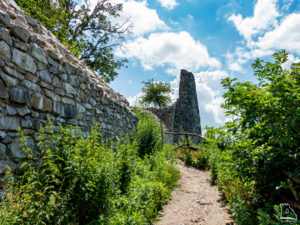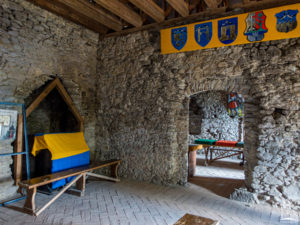Vinna / Tarna

Vinna or Tarna castle (Vinné) is in Slovakia in the historical area that we Hungarians call Felvidék. It is not far from Kassa (Kosice, Kaschau), near the town of Nagymihály, and the castle is also referred to as the castle of Nagymihály in historical records. The church dedicated to the Holy Cross dates back to the 9th century, its foundations can be tracked down near the village.

The owners of the village were the Hungarian Sztáray and Szirmay families. You can also find the Renaissance fortified mansion of the Sztáray family in the village that was built in the 17th century.

The present village was first mentioned in 1249 when the estate was acquired by a nobleman named Jakab from Péter’s son Sebestyén. The parish of the village was mentioned in this document. The castle was built on a 325-meter-high hill between 1270 and 1300 by Nagymihályi Jákó and Nagymihályi András of the Kaplyon Clan but it was most likely standing before 1312. We know that it was the time when the army of the Amádé sons of the Aba family took the castle and damaged it.

The mill of the village was mentioned in 1335 and its vineyard in 1336, it was the time when it became the property of the Nagymihályi family. In 1427 there were 37 homesteads in the village. In 1454, the village was already cultivating grapes on a large scale, and the descendants of Nagymihályi Eödön are mentioned as sharing the extensive vineyard here.

It is not known whether there were other large vineyards in the vicinity of the settlement, but indirectly it was indicated by the fact that the Bishopric of Eger confirmed the privileges of the vine-growers of Abaúj, Zemplén, and Ung counties as early as 1271. In the 16th century, Vinna produced 4981 akó (one “akó” was about 57 liters) of wine.

During the fall of 1472, Prince Casimir, the son of King Casimir of Poland attacked the Kingdom of Hungary. During the war between King Casimir and King Matthias Corvinus of Hungary, the castle of Vinna suffered considerable damage.
During the Dual Kingship of Hungary, part of the Nagymihályi family took the side of Queen Isabella, turning against Habsburg Ferdinand in 1556. We know, that Bánffy Sándor and Bánffy Gábor also joined them, along with Eödönffy János, led by Perényi Gábor. Their headquarters was Vinna Castle.

They kept a large garrison there and they often harassed the merchants and travellers who were passing by. King Habsburg Ferdinand tried to turn them to his side but it was in vain. Soon, Ferdinand took away the properties of Eödönffy János and Bánffy Sándor in 1556 and gave Vinna Castle to those members of the Nagymihályi family who remained loyal to him.

However, the new owners could not take the property over so easily. In 1558, Archduke Maximilian demanded that Bánffy Sándor cede the castle, disband his garrison, and send away his cavalrymen. The Archduke threatened him that he would demolish the castle otherwise. Yet, he could achieve it only in 1594 when the Habsburg troops attacked and burned Vinna Castle and its village.

The Nagymihályi family restored the castle not much later. During the anti-Habsburg wars of the Transylvanian princes, Vinna Castle was taken in 1644 by the army of Prince Rákóczi I György. In 1672, it was attacked by Ruthenian rebels, and the Kuruc troops held it during the Thököly Uprising. It was General Shultz and his army that took the castle back from them in 1685.

It was owned by Eödönffy László and Sztáray Ferenc in 1686. when the uprising broke out in the Hegyalja in 1697, Vinna Castle was not taken by the rebels. However, the Kuruc troops of Prince Rákóczi II Ferenc took it in September 1703, its captain became Pongrátz László, a member of the Nagymihályi family. Pongrátz had to cede the castle in January 1711 to the Imperial troops, led by General Damian Hugo Virmond.

A few years later, the Diet decided on the demolishing of many castles, and Vinna was among them. The Imperial army exploded the walls and most of the buildings. In 1715 there were 18 households in the village. In the 18th century, the village was also known as a place where fairs were allowed to be held.

In 1910 there were 1472 inhabitants, mostly Slovaks, with a significant Hungarian minority. In 2011, 1581 of its 1692 inhabitants were Slovak. Presently (2023), the castle is under repair but it can be visited.

Dear Readers, I can only make this content available through small donations or by selling my books or T-shirts:
Please, feel free to support me with a coffee here:
You can check out my books on Amazon or Draft2Digital, they are available in hardcover, paperback, or ebook:
https://www.amazon.com/dp/198020490X or at https://books2read.com/b/boYd81

My work can also be followed and supported on Patreon: Become a Patron!http://Become a Patron!
[wpedon id=”9140″]

https://hungarianottomanwars.myspreadshop.com/all

Here are more pictures of Vinna Castle:
Would you like to Adopt A Castle?


































